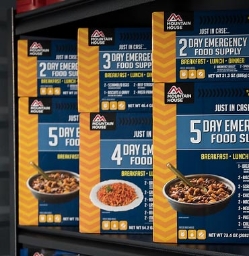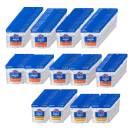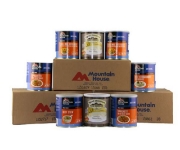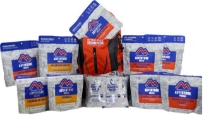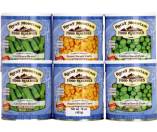Water, Your #1 Survival Priority
Posted by Harry Weyandt on Mar 23rd 2020
PREPAREDNESS 101: WATER, Your #1 Survival Priority!
Harry Weyandt
By Harry R Weyandt, Nitro-Pak.Com Preparedness Expert Having an emergency backup water reserve for you and your family is THE single most CRITICAL part on ANY preparedness plan, without exception! Most people think of food as the most important part but it is down the list of survival priorities when crisis strikes and comes after bug-out kits, first-aid, sanitation, light, heat/warmth and personal protection. Freeze-dried and other long storing foods should be a part of your overall preparedness plan, so don’t forget them.
FACT: Most adults can live up to 30 days without food, but without water, most people will die within 3-4 days. We cannot emphasize enough that emergency water storage is the single most important step of your preparedness planning. So let’s get to it.
HOW MUCH WATER DOES THE AVERAGE PERSON USE AT HOME PER DAY?
To start off with, I usually like to give people a real life statistic that shocks most people about how much water the average person uses per day in total water usage. What would be your guess? Perhaps 5 gallons to 25 gallons. Maybe 30 gallons? Here’s the shocker. Estimates vary from region to region, but according to The Department of Interior USGS, the average person uses up to 100 gallons of water per day! About 70% of that total is used within your home. So, were you even close?
Now I know what you are thinking, “there’s no way I consume and drink that much water per day”, and you would be right. So the next logical question is….
HOW MUCH WATER SHOULD I STORE FOR EMERGENCY PREPAREDNESS?
Most preparedness experts, FEMA, Ready.gov and the American Red Cross recommend storing a minimum of 1 to 2 gallons per person per day and plan for a minimum of 3 to 7 days. The USDA recommends that the average adult drink about 1 gallon of water per day (I said water, not soda pop!). In addition, water used for hygiene, brushing teeth, meal preparation and, in an emergency, to take a quick towel bath, would require another gallon of water or more. So here’s what we recommend:
- GOOD: 1 gallon per day x 3 days = 3 gallons per person/per day minimum
- BETTER: 2 gallons per day x 3 days = 6 gallons p/p
- IDEAL: 2 gallons per day x 7 days = 14 gallons p/p
- EXTRA MILE: 2 gallons per day x 14 days = 28 gallons p/p
(Under the “Extra-Mile”, a family of 4 would need 112 gallons of water for 2 weeks)
WHAT WATER CONTAINERS ARE BEST TO USE?
My suggestion is to DIVERSIFY your water holdings (sounds like an investment portfolio doesn’t it). I like splitting my water storage into to two broad categories 1) grab-n-go to quickly leave at a moments notice and kept with my bug-gear, 2) the balance of my water storage in bulk storage containers. Here’s my recommendations:
QUICK GRAB AND GO WATER RESERVES:
FIRST, a WORD OF CAUTION. Never ever use previously used containers like milk jugs, bulk soda syrup or other food containers. These containers can NEVER be 100% cleaned out of their previous product no matter how much you try. All plastic has microscopic pores and they will contaminate your water if you use them. NEVER USE USED CONTAINERS!!!
- The easiest and most convenient option is to purchase several cases of bottled water from our local store. You probably already have some at home right now. Just buy a few more. If these are 16 ounce bottles and there are 24 to the case, that would equal 3 gallons of water. This should be your minimum target per individual PER DAY plus any full size pets you have, for 3 days. These bottles are easy to toss in your car when things hit the fan. This water should be rotated at least 1x per year to insure freshness and safety.
- Another possibility is purchasing 1 or 2.5 gallon jugs of purified water at the store. This might be your least expensive way for your grab-n-go bug-out water storage, but remember that these, like the water bottles above, need to be rotated yearly. Large 5 gallon water cooler bottles can also be used. Some companies will provide crates for stacking these large bottles too. Please note, that standard store bought plastic containers are not intended for long term storage and are made to break down, become brittle and will crack over time
- Datrex® Emergency Water Ration Pouches. These sterilized and purified foil sealed Datre 4.2 oz. water pouches are the same ones that are used on cruise ships and lifeboats worldwide. They have a minimum shelf-life of 5 years and require no rotation during this time. They are very durable and can survive being frozen and still remain good afterwards. Emergency Operating Centers (EOC) and businesses like these pouchesbecause they can be dispensed easily in any emergency without waste.
- Five (5) gallon water storage containers are another convenient way to store gab-n’-go water to keep with your 72 hour bug-out bags and kits. These are heavy duty versions of the ones sold for camping in sporting goods stores. They have also been designed to easily stack up to 3 high for more convenient storage.The down side is that this water need to be treated for safe long term storage(see 5 year water storage preserver).
 Another popular option is the modular stacking 3.5 gallon WaterBricks®.These are specifically designed for water storage and bulk food storage. These can stack up to 6’ if desired. Each WaterBrick has a carrying handle on the end for quick pick-up and go.There is an accessory spigot cap for easy water dispensing too. These like the 5 gallon water containers shown above, require the water to be treated for safe long term storage (see 5 year water storage preserver).
Another popular option is the modular stacking 3.5 gallon WaterBricks®.These are specifically designed for water storage and bulk food storage. These can stack up to 6’ if desired. Each WaterBrick has a carrying handle on the end for quick pick-up and go.There is an accessory spigot cap for easy water dispensing too. These like the 5 gallon water containers shown above, require the water to be treated for safe long term storage (see 5 year water storage preserver).
LONG TERM WATER STORAGE RESERVES:
First, another word of warning. I hear people all the time talk about being able to buy previously used 55 gallon barrels for their water storage. Don’t fall for this trap!
Here’s a real life story. A good neighbor of mine years ago decided, against my advice, to purchase four used 55 gallon drums that had previously had been used for bulk “coke” syrup to “save money”. He washed, rinsed and power sprayed each container thoroughly and even used baking soda to rinse them out. In the end he had saved probably about $100 for his efforts…so he thought. After treating his water and letting it store for about a month I challenged him to pump some out and taste it. Oh boy, he was so fuming mad at what he found out about his nice used storage containers. The water fermented and tasted awful. In short order, he tossed out the containers and came to me to purchase new ones for his family storage. The gist of this story is, don’t be penny wise and end up being pound foolish. Buy only new, never used containers for your water storage!
Heavy-duty water storage drums come in many different sizes from 15 to 55 gallons in size. Make sure that they are BPA-free and certified by the FDA as being food grade compliant. Many barrels are NOT and intended only for chemical storage. Typically the blue versions are OK for water storage. Today there are a couple of companies making super-sized water containers that can store up to 250 gallons. Whatever size best suits your needs, remember that water is HEAVY and weighs 8.35 pounds per gallon. Once these containers are filled, they are immovable and will stay there until empty. Once again, this water needs to be treated for long term storage (see 5 year water storage preserver ).
One suggestion I would make to you when storing ANY water is not to store the container directly on a cement floor or ground. This can be accomplished by using plywood or 2×4 boards covering the entire base of the container to act as a protective safety barrier. You see, all plastic breathes and can allow transfer of odors and contaminates from the ground. Keep all fertilizer, gas, paints, and other chemicals away from your stored water.
WARNING: Water Never to be Used for Emergency Drinking
Never, ever use swimming pool, spa tub, water fountains, water beds, even if you have a water filter. Why? These waters are contaminated with chemicals, acids, algaecides, and other harmful chemicals which can be deadly. These water sources might be able to be used for bathing, hair washing or operating flush toilets in an emergency. In addition, we do not recommend using flood control canal water for emergency drinking water either since these canals are often polluted with sewage and who knows what.
© 2017 Nitro-Pak Preparedness Center Inc.
Harry R Weyandt is the founder and owner of Nitro-Pak Preparedness Center Inc., one of America’s oldest and most respected preparedness companies. He has been a leading authority in the preparedness industry for over 30 years and has been interviewed by CNN, ABC News, FOX News, The New York Times, USA Today and The Wall Street Journal among others as an expert in his field. He lives in Utah with this wife Vickie along with their children and grandchildren. His hobbies are boating, camping, international travel and anything to do with preparedness.
****5 year preserver link to:
